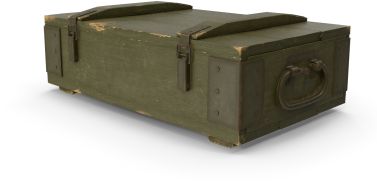During the night of 5th to 6th June 1944, the landing plan known as operation “Neptune” was initiated. This landing on the Normandy coast took place not only by sea, but also by air. Airborne troops played a crucial role in the success of the landing inland especially at Utah Beach. It was necessary to isolate Utah from any German reinforcements due to the swamps.
Composed of the 501st, 502nd and 506th Parachute Infantry Regiments, and of the 327th Glider Infantry Regiment, each regiment was assigned a mission on D-Day. Commanded by Lieutenant-Colonel Robert F. Sink, the 506th Parachute Infantry Regiment was assigned the mission to seize two of the four exits from the beache of Utah on which the landing was due to take place at dawn on June 6th.
- Exit N°1 running through Pouppeville, a small town northeast of Carentan (see map below)
- Exit N°2 running from the beach through Haudienville to Sainte-Marie-du-Mont (see map below)
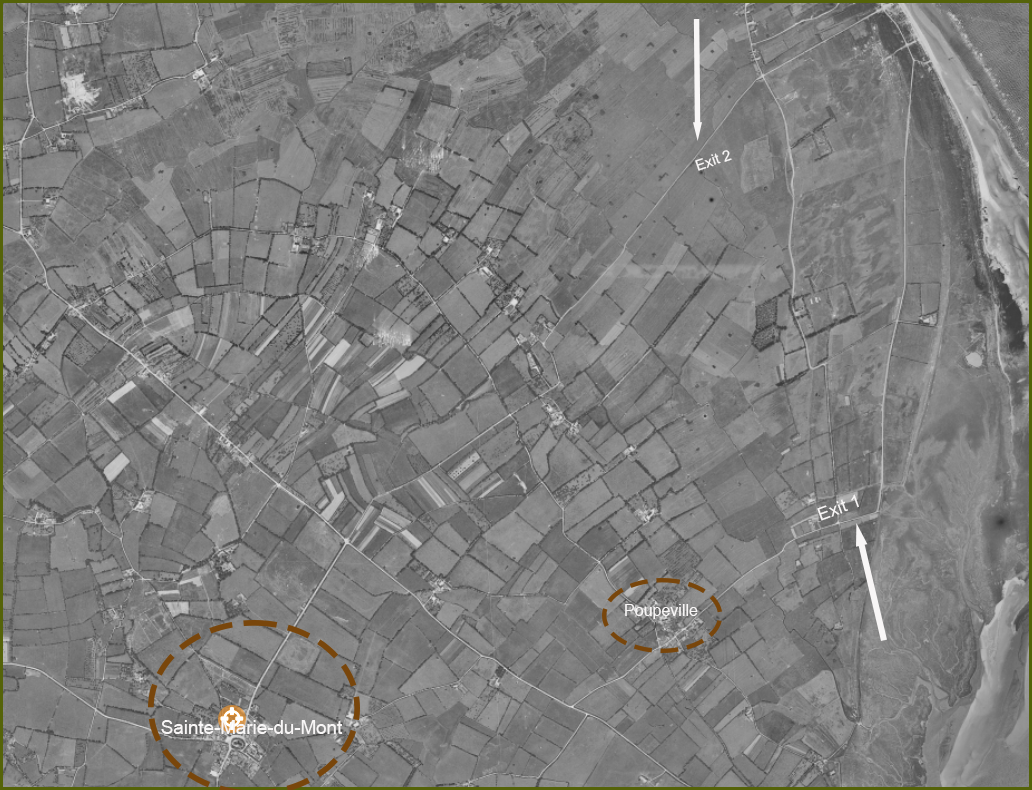
Objectives of the 506th Parachute Infantry Regiment - ©IGN
By securing these causeways, the 506th Parachute Infantry Regiment would enable the 4th Infantry Division to move inland from Utah Beach. The 506th Parachute Infantry Regiment's other mission was to establish a defensive line to the rear of Utah at Audouville-la-Hubert and capture the two bridges near the mouth of the Douve between the lock and the sea.
On D-Day, each battalion of the 506th Parachute Infantry Regiment had a specific objective as follows:
- 1st Battalion will send a reinforced platoon from "B" Company to the area south of Sainte-Marie-du-Mont to draw the attention of German forces stationed in town and prevent them to counterattack the causeways. The reminder of the battalion supported by Regimental Headquarters Company, would stand at Hiesville in reserve.
- The 2nd Battalion was to move westward along a line running north of Sainte-Marie-du-Mont toward Houdienville. From that point, the battalion’s northern element (“E” Company) was to launch an attack westward for the purpose of clearing Exit N° 2.
- The 3rd Battalion was to move from its drop zone and seize two bridges near the mouth of the Douve River at Le Port. When that move was complete, the 3rd Battalion was to continue its drive, crossing the Douve River and seizing the high ground in the direction of Brévands .
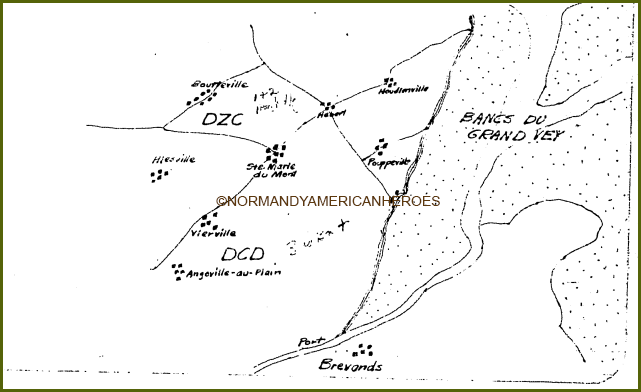
Map of the planned operation of the 506th Parachute Infantry Regiment.
The 1st and 2nd Battalions of the 506th were to land north of Hiesville, and northeast of Sainte-Marie-du-Mont, on Drop Zone “C”, while 3rd Battalion was to land south of Vierville, and northeast of Saint-Côme-du-Mont, on Drop Zone “D”.
Shortly after midnight, the serials carrying the three battalions and their attached troops crossed the English Channel and headed toward France. However, due to the heavy fog bank which obscured the ground and the fire coming from the flak, aircraft attempting to avoid fire broke formation, causing paratroopers to scatter widely on the ground and miss the proposed drop zones. As a result, only 10 of the 81 aircrafts scheduled to drop their men in Drop Zone "C" reached their target.
The 1st Battalion's drop pattern was approximately effective, with only one of its sticks dropping far from the proposed drop zone. However, the men were scattered, requiring an extra four hours to get the battalion moving toward its objective. The 2nd Battalion was completely out of Drop Zone “C” and only one plane dropped its stick in the surrounding area of the proposed drop zone. The 3rd Battalion had the best drop of any battalion, getting most of its men in the general vicinity of Drop Zone “D”, but not enough to give it any practical advantage. As a result of this poor airdrop, hours were lost gathering men to reach the different objectives assigned to each battalion.
In the vicinity of Drop Zone “D”, the pathfinders were engaged against Germans and the paratroopers of the 506th Parachute Infantry Regiment were under machine gun fire, which caused between 15 and 20 casualties among the 3rd Battalion just after they landed.
As a result of airdrop errors, the unit was dispersed over land and scattered to the four corners of the peninsula. This error, sometimes of just a few miles, complicated the entry into action of the airborne troops in the early hours of D-Day. In this clutch, the cricket signal carried by the men proved useful for identifying anyone seen moving about. Assembling the men was a long process. Mixed groups of men from different regiments or battalions were formed to reach their objectives. Other men served as guides at road junctions, when officers picked up the men they found along their path.
At Drop Zone “C”, (see map below) the assembly areas for the 1st & 2nd Battalions and Regiment Headquarters were three orchards strung across the drop zone from north to south. The 2nd Battalion was supposed to assemble on the northern orchard and move off to attack and cover Exits N°1 and N°2. The 1st Battalion was supposed to assemble on the southern orchard and proceed to its own objective, heading toward Sainte-Marie-du-Mont. Regimental Headquarters, after assembling in the center orchard, was to move about 1 ½ miles southward and set up a command post in a farm house in the hamlet of Caloville.

Lieutenant-Colonel Sink was very fortunate as he jumped directly on the proposed drop zone, with his staff section. At that time, the drop zone was under small arms fire. When he landed, Lieutenant-Colonel Sink had to struggle with his harness to get out before he was shot. Once released from his harness, he walked over and found Lieutenant Samuel S. Burns of the 1st Battalion Headquarters Company. Lieutenant Burns was badly hurt in the leg. Before continuing his mission, Lieutenant-Colonel Sink helped Lieutenant Burns and placed him in a hole.
After that, he headed east, taking a path parallel to the main road for about 300 yards into Sainte-Marie-du-Mont. On the roadway he found his S-3 and S-4 and the headquarters commandant, Captain Edward A. Peters. They didn't know where they were, so they continued east to the first house they saw. They knocked on the door, wanting to know where they were. A resident came out and showed them where they were on the map he had been handed; approximately 250 yards from the proposed command post. They also asked him about the Germans, and he said they were all around and that there were large numbers of them in Sainte-Marie-du-Mont.
Lieutenant-Colonel Sink’s party was the first to arrive at the proposed command post near the drop zone. They picked up a few men as they went along and he ordered to collect more of his men and bring them back to the rendezvous point.
One and a half hours after the jump, Lieutenant-Colonel Sink, with his executive officer, S-1, S-3 and S-4, the Headquarters Commandant had assembled approximately 40 men at the command post in the vicinity of the drop zone. In the meantime, the 1st Battalion was in the process of gathering the men in their own assembled area. Lieutenant-Colonel Sink had also found Lieutenant-Colonel William L. Turner, Commanding Officer of the 1st Battalion of the 506th Parachute Infantry Regiment who had assembled some of his men at his rendezvous point.
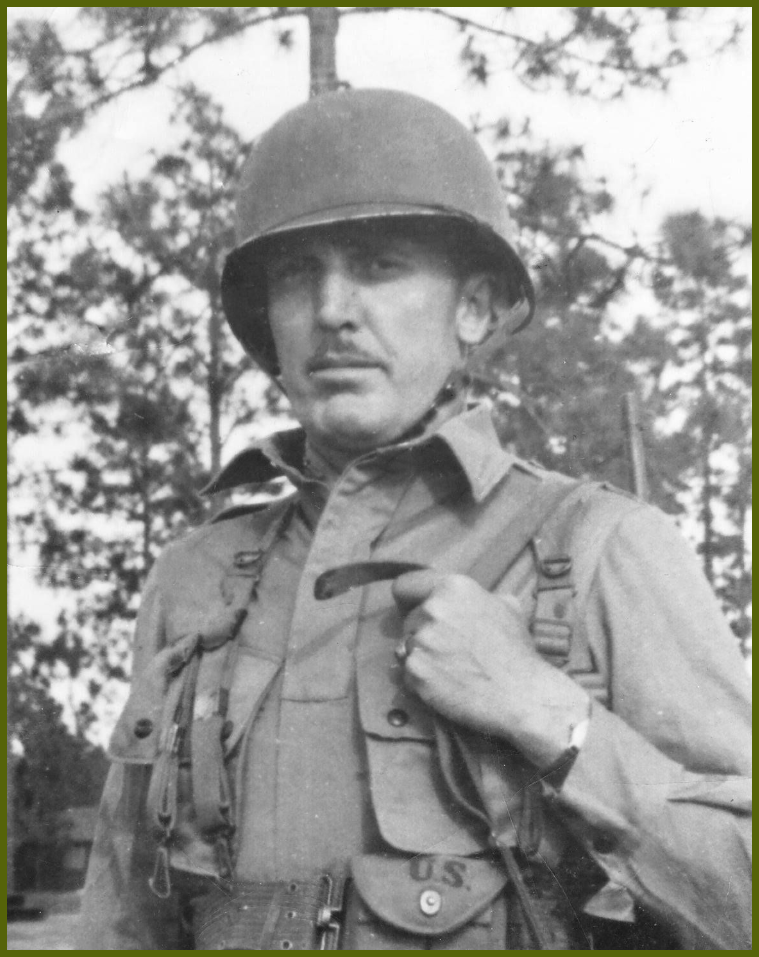
Lieutenant-Colonel Robert Sink- ©Findagrave.com
At this time of the night, there were no radios, so it was impossible for the regimental commander to make contact with the 2nd and 3rd Battalions.
Lieutenant-Colonel Sink then told his men: “We’d better get along to the command post at Caloville. The rest of the men will probably skip this command post and go straight on”.
When they got there, they asked the locals if they were in the right place. The Frenchman, living at this location, said that he had never heard of “Caloville”. Nevertheless, the inhabitant pointed out the direction of the other villages in the vicinity. They realized they'd come to the right place.
The enemy had established machine gun nests and small detachments were patrolling the area, and wherever the men dropped, they encountered enemy groups in their immediate vicinity. On Drop Zone “C”, casualties, due to fire or the jump, were light. 1st Sergeant Albert H. Miller got both. He sprained his ankle when he landed, and before he could get out of his harness, a marksman, whom he thought was a French civilian, came out of a house and shot him in the right leg.
During the rest of the night, Lieutenant-Colonel Sink went in search of the 2nd Battalion, but failed to find the men under the command of Lieutenant-Colonel Strayer. Just before daylight, Lieutenant-Colonel Sink asked Lieutenant-Colonel Turner of the 1st Battalion and assigned him the 2nd Battalion's objectives, namely to secure Exit N°1 at Pouppeville with the men he had at disposition. He had concluded that they had had a bad drop, which was true.
Lieutenant-Colonel Strayer and most of his men had been dropped well to the northward in 502nd Parachute Infantry Regiment's area. When daylight came, they were still in the vicinity of the northern causeways but were proceeding toward Pouppeville. Despite this bad drop, the 2nd Battalion was more effective at assembling the men than the other elements of the regiment.
Captain Clarence Hester, S-3 of the 506th Parachute Infantry Regiment, 2nd Battalion, landed with the leading elements of the battalion. He figured that he had landed on one end of the drop zone. So, he walked back 500 yards in the direction from which the planes had come, thinking this would put him at about the center of the jumpfield. At that point, he put up a string of amber bundle lights in a tree to signal his position to his men. The enemy was nearby, shooting on the planes. But once the men hit the ground, they were out of range of these shots. Captain Hester was not sure of his location, so he sent Lieutenant Lewis Nixon, S-2, to find out where they were. He headed to the nearest village and was told by a Frenchman that the village was Fourcarville.
The village was at that time held in some strength by the Germans as Lieutenant Harold Hoggard and his patrol from 502nd Parachute Infantry Regiment had not yet put in their appearance. In more than an hour a considerable group had gathered around Captain Hester, including a communications platoon, a machine gun platoon, approximately 80 men from Battalion Headquarters Company, 90 men from “D” Company, 6 from “F” Company and 8 from “E” Company, with an officer. To this group were added 20 men from the 508th Parachute Infantry Regiment who jumped in the surrounding area.
By 0330am, Lieutenant-Colonel Strayer and 15 men came along the road, joining the column. This force of 200 men moved out at 0430am and headed south along the main road. “D” Company in the lead, the column met determined opposition from Germans. During the first stage of advance toward the exits, about 25 enemies were killed or taken prisoners, and four machine gun nests were destroyed. At Saint-Germain-de-Varreville, around 1100am, the column came under fire from a German artillery battery. Nevertheless, elements of “E” Company passed through the gun and reached its objective, Exit N°2, at 0130pm. Lieutenant-Colonel Strayer caught up with them by 0300pm. They had kept the German battery occupied until Captain Richard D. Winters of “E” Company returned with a group of tanks to collapse the battery’s position. At 0600pm, the 2nd Battalion had assembled at Exit N°2 with approximately 300 men.
As for the 1st and 2nd Battalions, the 3rd Battalion was scattered on landing around Drop Zone “D”. Unfortunately for the paratroopers, the Germans had set fire to a house that lit up the surrounding countryside, giving the occupiers a glimpse of the paratroopers' jump trajectory.
Captain Charles G. Shettle, Battalion S-3, noticed that the entire area was covered by machine gun and mortar fire. So he crawled into a ditch and oriented himself. The heaviest enemy fire seemed to be coming from Angoville-au-Plain. He saw no lights and heard no sounds indicating the presence of any other paratroopers, so he moved to the southwest, in the direction of Les Droueries, as he knew it was the assembled area of the 501st Parachute Infantry Regiment. He met one paratrooper on his way, but the assembled area was empty.
So he decided to turn back to Angoville-au-Plain, and on his way picked up two officers and 12 men. The party decided to strike out for their objective and proceeded to Bridge N°37 across the canal de Carentan near Brévands. En route, they picked up more men. The battalion reached the bridges over the canal near Le Port at 0430am. There was fire from the opposite bank, but the group managed to secure the east bank and take control of the two bridges. Five more officers and 15 more men joined them and it was decided to force a crossing of Bridge N°37 and attempt to establish a bridgehead.
Two scouts were sent across the bridge under enemy fire. Then, Lieutenant Kenneth H. Christianson and Lieutenant Rudolph E. Bolte of “H” Company, took 5 men each and crossed under the bridge, followed by a group under command of Lieutenant Richard P. Meason of “H” Company. This party killed 13 Germans and knocked out 3 machine gun positions. Nevertheless, they found that as soon as they destroyed a gun, the crew was replaced by a reserve crew with another gun. Thus, running out of ammunition, the Americans were forced to withdraw.
Lieutenant Fred T. Broyhill of the 3rd Battalion’s Headquarters was sent with two men to attempt to break through the German lines toward help. The remainder of the day, the party held the position with what they had at their disposition. In the afternoon, Captain Shettle was informed that the 501st Parachute Infantry Regiment was fighting for the La Barquette lock. He took two men with him to make their way to Colonel Johnson. He made contact with the Battleship USS Nevada, and Captain Shettle prepared a message to the Commanding General of the 101st Airborne Division, Major General Maxwell D. Taylor.
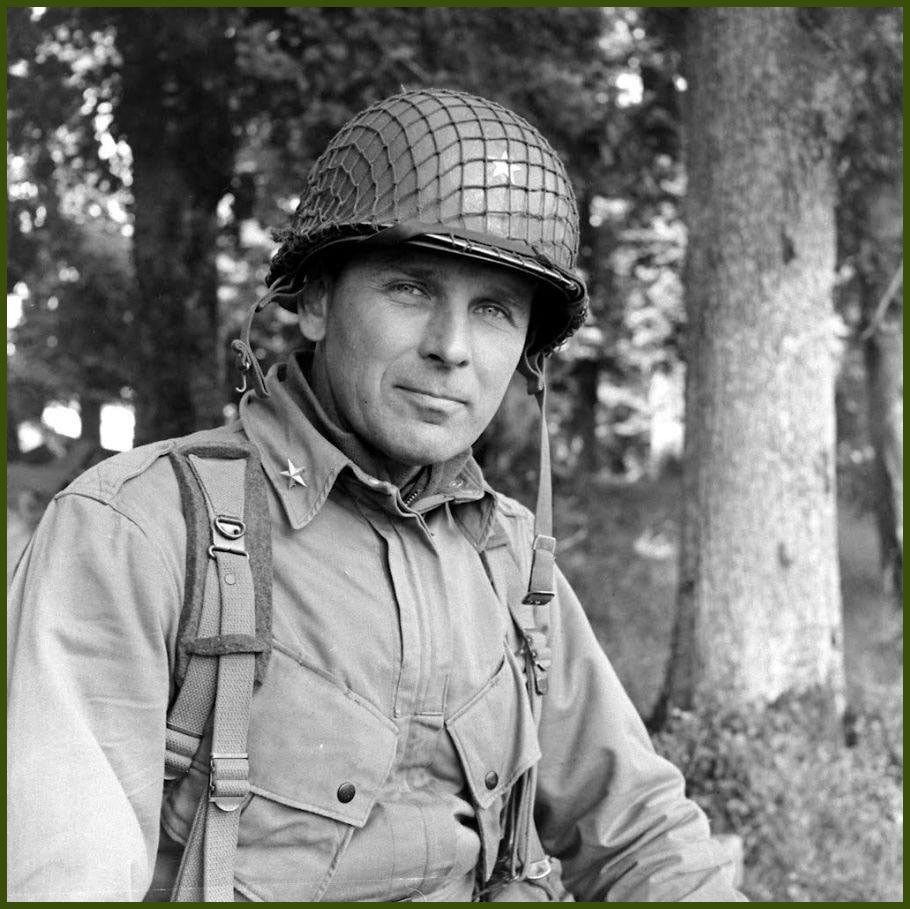
Major General Maxwell Taylor
That night, Captain Shettle’s group was reinforced by 40 men who had dropped in the vicinity of Carentan. At 0200am, Germans attempted to counterattack to cross the Bridge N°37, but were repulsed with heavy fire.
The following day, the Germans simply shelled with mortars and artillery the position held by the men of Captain Shettle. At 1200pm, Captain Shettle coordinated an attack on the Germans positions, with the support of a P-47, which bombed the opposite side of the bank. Nonetheless, several bombs were dropped on American positions and others hit the bridge. Chaplain McGee probably avoided the worst by unfurling the identification flag, just as a plane was about to strafe the position.
At around 0400pm, a troop movement was observed approaching from the rear, requiring Captain Shettle to set up a defensive line behind him. He also sent a party to observe the movement of the Germans. The patrol confronted the enemy forces, approximately 300 yards to the rear, and bluffed the Germans into believing that their strength was greater than their actual force. There was a quick skirmish and they took 255 prisoners and killed between 30-50 Germans. During the night, the Germans tried to blow up the bridge and were repulsed by small arms fire. Elsewhere in the countryside, Lieutenant Colonel Turner's patrol reached Exit N°1 after fighting several German encounters. They found that the town of Poupeville was already seized by a detachment of division headquarters and the men of the 4th Infantry Division were already proceeding the Exit N°1 causeway, advancing inland.
Deprived of communication and with no precise information on the positions of the enemy forces, Colonel Sink sent out several patrols to get an overview of the current situation. One patrol under Captain Peters of Regimental Headquarters Company, encountered an enemy machine gun nest. They knocked out two machine guns, but Captain Peters was killed trying to blow up a third one.
At the command post, Lieutenant-Colonel Sink had managed to establish radio contact with the 2nd Battalion around 0730am, which joined the command post in the evening, after the completion of its objectives. During the morning, he sent patrols looking for the 3rd Battalion. At 1100am Lieutenant-Colonel Sink and his S-3, Major H. H. Hannah, headed toward Saint-Come-du-Mont to pursue the research. One mile southwest of Vierville, they encountered German resistance and killed several of them.
The detachment came close to the end, taking their truck down a cul-de-sac. Germans were in the ditches on either side of the road. Fortunately for the occupants of the jeep, the Germans seemed more surprised and dispersed as soon as the Americans started firing. The driver managed to turn around and go back the way they came. Word reached the command post that a party of 70 men from various regiments were fighting at Holdy near Sainte-Marie-du-Mont, trying to neutralize a battery of 105mm, which was not mentioned in any previous G-2 information. Lieutenant-Colonel Sink sent a patrol under the command of Captain Knut H. Raudstein of “C” Company and Captain Lloyd E. Patch of 1st Battalion Headquarter Company to the action.
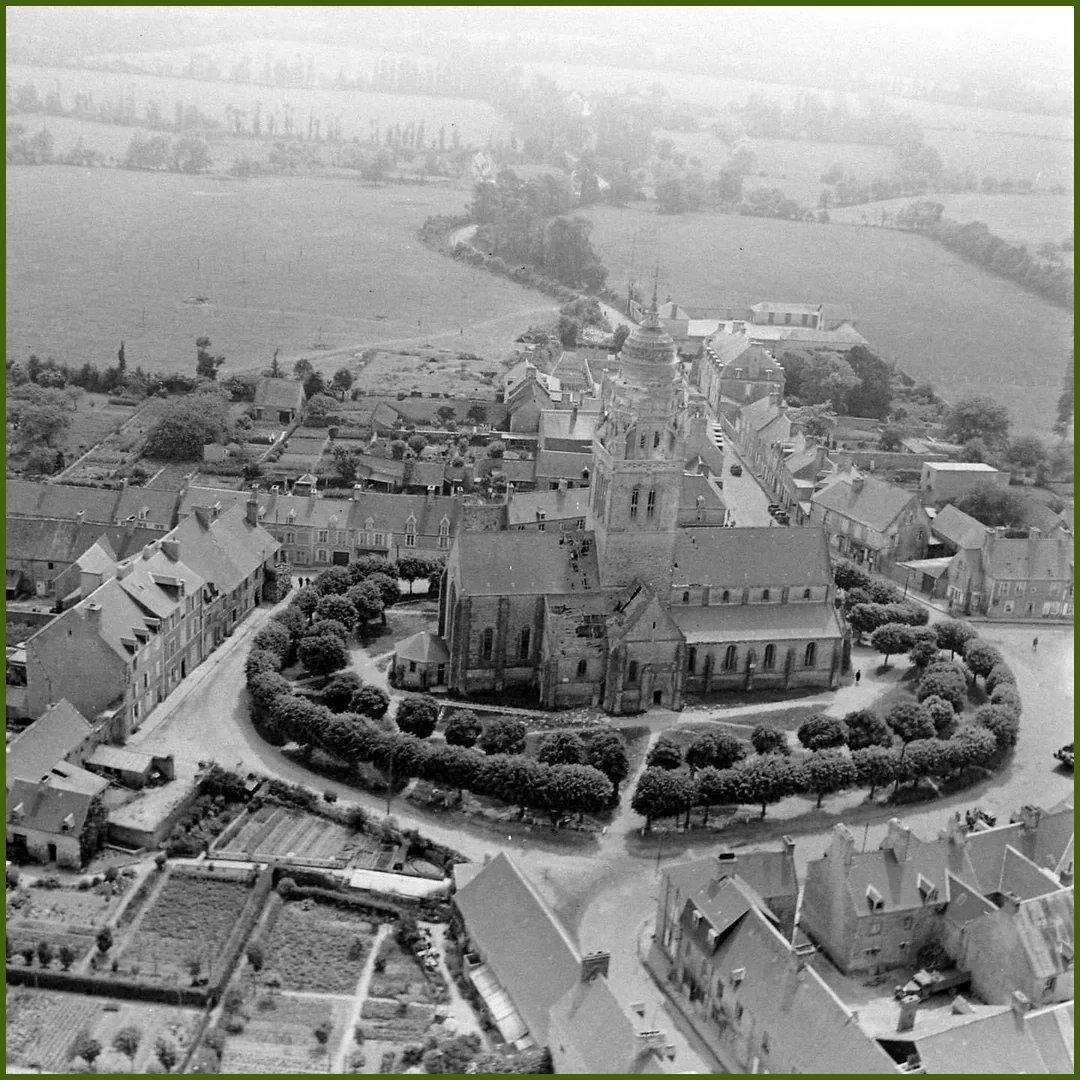 Aerial view of Sainte-Marie-du-Mont on June 6th 1944.
Aerial view of Sainte-Marie-du-Mont on June 6th 1944.
The patrol split in two: Captain Patch's unit went around one flank, while Captain Raudstein's unit bypassed along the other flank. The position of the battery was not protected by a shelter, but simply hastily set up on an elevated position. There were around 50 Germans defending the guns, and they were shot on the spot. An American had fired a rocket with his bazooka and inflicted several casualties to the enemy and the rest were killed by small arms fire from the infantry.
Captain Patch had decided to lead his men in an attempt to capture Sainte-Marie-du-Mont, which was occupied by a relatively strong enemy force. He reached the town, however his attempt was just a reconnaissance mission. He noticed that the Germans were using the tower of the church as an observation post. Returning to the battery, he gave the order to fire on the church, and knocked out the observation post with the first couple of rounds. They returned to Sainte-Marie-du-Mont.
In the meantime, the 4th Infantry Division headed to the town from the other side. In response to this pressure from both sides, the enemy withdrew.
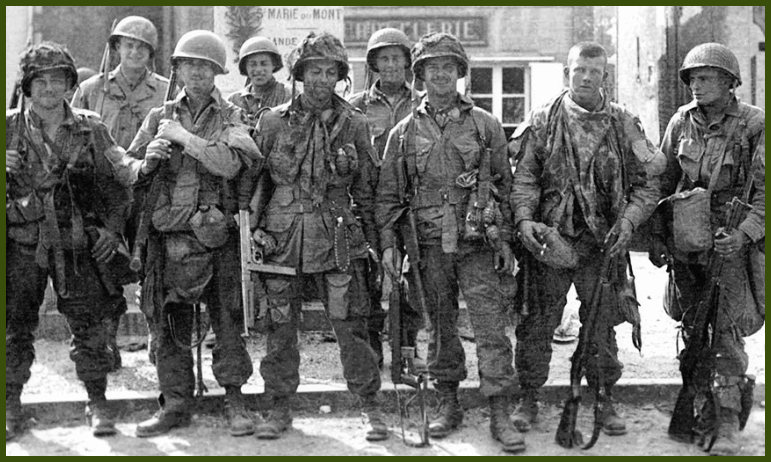
Troops of the 101st Airborne Division in Sainte-Marie-du-Mont.
Back to the hamlet of the Holdy, the officer in charge wanted to blow up the guns, as he didn't have enough men to defend them, but Lieutenant-Colonel Sink wanted them, so he sent four jeeps to bring them back, however the German began to shell the position, before the jeeps reached the guns. The lieutenant decided to blast the cannons and blew up three of them, the last one being recovered in time by the jeep patrol.
This increased the regiment's firepower for a short time. The cannon targeted a German battery along the Douve River, which was harassing the men of the 506th Parachute Infantry Regiment. Nevertheless, the cannon blew up, killing an artilleryman in the blast. As groups were dispatched to the area to accomplish various objectives, the command post was left all the more vulnerable. Lieutenant-Colonel Sink positioned a few men on the heights, but realized he didn't have enough men to hold the position in the event of an attack. Unluckily, his position came under heavy enemy fire.
All the soldiers he had at his disposal, officers and doctors, grabbed their weapons and rushed up the hills to defend the position. The skirmish along the hedgerows lasted about 30 minutes, and then the shooting died down. Later in the day, the Americans came under a second attack, while Lieutenant-Colonel Sink expected a bigger one during the night. All day long, German snipers targeted the men in the area from the cover of the hedgerows.
Lieutenant-Colonel Sink had gone to Hiesville in the morning to find the division's command post. He found no commanding general to inform him of the general situation. Late in the afternoon, Major-General Taylor and Brigadier-General Anthony McAuliffe reached the regimental command post, for the purpose of drawing up plans for the movement south on the following morning.
They had to reach the Douve River as quickly as possible to see if the 1st Battalion's mission had been accomplished, namely to blow up the bridges. If this objective was not achieved, the enemy could send their tanks to break through the American line. So, a reconnaissance party was sent to Vierville, while Major-General Taylor returned to his command post.
At dusk, Lieutenant-Colonel Sink still had no contact with his 3rd Battalion.
During the night, Lieutenant-Colonel Sink prepared the plan for the southward movement scheduled for the following morning at 0430am. The 401st Glider Infantry Battalion was the leading element of this force which was to proceed towards Saint-Côme-du-Mont. In fact, the 401st Glider Infantry Regiment had never reached Caloville that night, so it was up to the 1st Battalion to lead the column.
Once again, snipers harassed the column as it moved forward, making it impossible to advance down the dirt road to Vierville. They fired from hedges or trees along the road, slowing the advance of the 506th Parachute Infantry Regiment. Lieutenant-Colonel Sink kept his men on the move, despite these guerrilla actions by the Germans. The advance was made with a few men moving ahead to redirect the attention of the snipers, while the column slowly progressed, stretching out over a long distance, men deployed on either side of the road.
When the column finally arrived in Vierville, it first had to clear the town of snipers hiding in houses and buildings before continuing on to Carentan. Lieutenant-Colonel Sink restrained his men from firing unless they were shot first. This was to avoid allied fire. Nonetheless, he decided not to fire on a German column moving into the open approximately 2,000 meters from their position, as they were unable to identify them and, according to Lieutenant-Colonel Sink: “Germans wouldn’t be so dumb as to move around that way in daylight”.
From Vierville, the column was separated with two objectives, as follows:
- The 2nd Battalion had the general mission of moving off to the left of the main road and clearing the enemy from the vicinity of Angoville-au-Plain.
- 1st Battalion to go through Vierville clean and moved on.
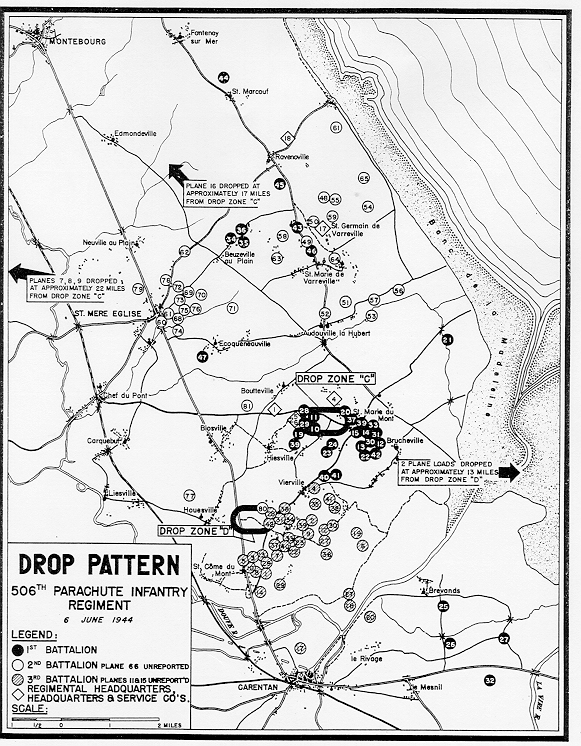
©Airbornetroops.com
The column faced German resistance from both sides of the road. Firing from the hedgerows and buildings, Germans inflicted several casualties in the ranks of the 2nd Battalion which was pinned down. The advance of the battalion was halted, and the men jumped in the ditch alongside the road to cover themselves. The arrival of American medium tanks unlocked the situation, by supporting both battalions and 2nd Battalion could make its way through Vierville.
After three hours of skirmishing, the Germans were chased away from Vierville and few of them were captured. It was only after this that the 2nd Battalion was able to pursue its objective, namely Angoville-Au-Plain. During the afternoon, Regimental Headquarters and Headquarters Company also reached Vierville.
The 1st Battalion, which had come through Vierville, moved out along the right of the road toward Beaumont. The crackling sound of gunfire could be heard, as the flank of the column was harassed by the enemy. Lieutenant-Colonel Turner organized his men to defend his right flank and maintain a constant fire to prevent any German breakthrough. Lieutenant-Colonel Sink sent the “D” Company of the 2nd Battalion to support and cover the flank of the 1st Battalion.
As the force approached Beaumont, the difficulties increased. The Germans had prepared fire positions in order to repel the American advance. The 1st Battalion was cut off from both flanks, while the enemy was moving along the hedgerows. The men were pinned down by the fire concentration. Lieutenant-Colonel Sink went out to see what was slowing down the battalion's progress. He sent a messenger to Lieutenant-Colonel Turner in order to report the situation. Lieutenant-Colonel Turner was trying to direct his tank artillery in such a way as to neutralize the enemy fire positions. During this assault, Lieutenant-Colonel Turner was killed in action.
It was Major Foster, his executive officer, who had taken over and tried to get the battalion forward. But they were still pinned by enemy fire. At the same time, “D” Company arrived, with the support of light tanks. Finally, with this extra the Germans were pushed back and the battalion moved through Beaumont during the end of the afternoon. The battalion lost many men and Major Patch took the lead, after Major Foster was wounded. From this moment, the new regimental command post was located at Angoville-Au-Plain. “D” Company received the order to withdraw, for the purpose of its attack the following morning.
During the night, the 1st Battalion received reinforcements from two battalions of 501st Parachute Infantry Regiment, one of 401st Glider Infantry Regiment and a few light tanks. The plan was prepared for the attack of Saint-Côme-du-Mont, which would pave the way for one of the 101st Airborne Division's main objectives: the taking of Carentan.
Written by Hugo Di-Fazio, NAH Executive Assistant.












